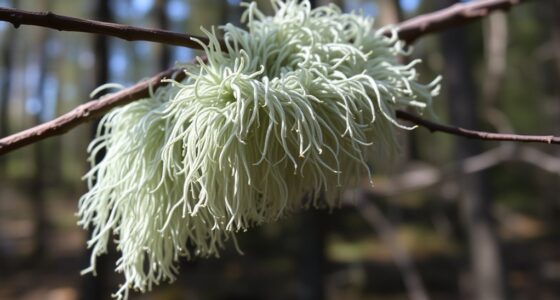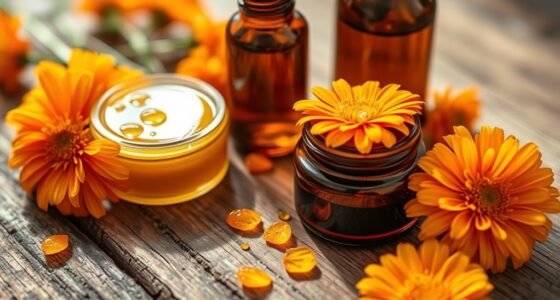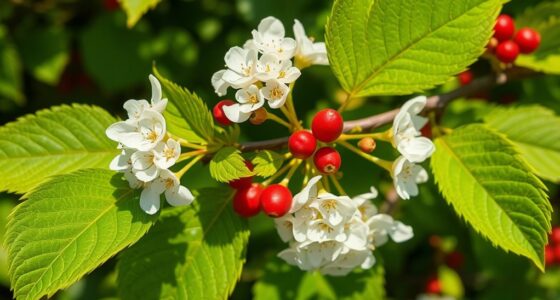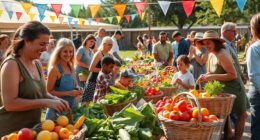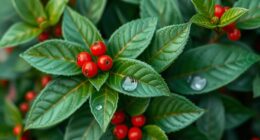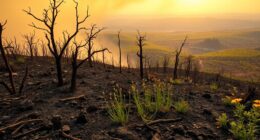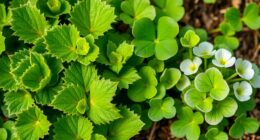To craft a wild first-aid kit from your local flora, start by properly identifying safe and effective plants like plantain, yarrow, and calendula. Harvest responsibly using scissors, avoiding protected areas, and leaving enough for plant regeneration. Prepare remedies by drying, storing in airtight containers, and creating poultices or tinctures for wounds, bites, or burns. Carefully test your remedies for safety. Continuing your exploration will reveal more tips to build and maintain an effective, sustainable natural first-aid kit.
Key Takeaways
- Identify and sustainably harvest local medicinal plants like yarrow, plantain, and chickweed for first aid remedies.
- Prepare plant-based poultices, infusions, and salves, ensuring proper drying, storage, and labeling for safety and efficacy.
- Include dried herbs, fresh leaves, and plant extracts in waterproof containers for easy access in emergencies.
- Test remedies on a small skin patch to check for allergies or adverse reactions before use.
- Document plant sources, preparation methods, and effects to maintain safety and improve future treatments.
Identifying Safe and Useful Plants in Your Area
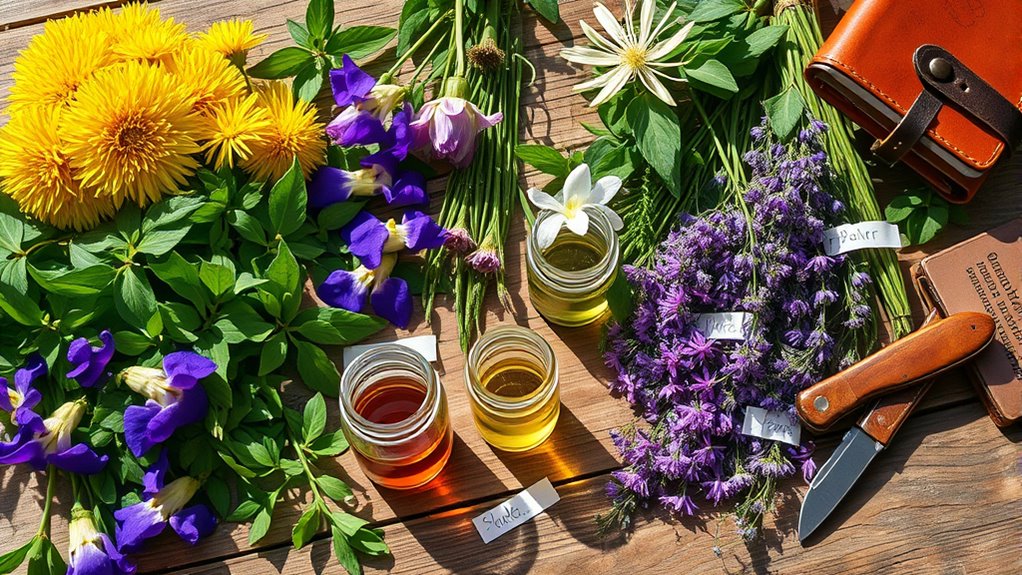
To effectively use local flora in your first-aid kit, you need to learn how to identify safe and useful plants in your area. Proper plant identification is essential to avoid poisonous or harmful species. Start by studying regional plant guides, noting key features like leaf shape, color, and growth patterns. Pay attention to details such as flower structure and bark texture, which help distinguish safe plants from toxic lookalikes. Remember, foraging safety is critical—never consume or use a plant unless you’re absolutely certain about its identity. Take your time to observe and verify each plant carefully. Gathering knowledge from trusted sources ensures you can confidently find medicinal plants when needed, minimizing risks and making your wild first-aid kit both effective and safe.
Gathering and Harvesting Flora Responsibly

When gathering local plants, make certain you can identify which ones are edible and safe to use. Always harvest in a way that leaves enough for the plants to grow back and support the local ecosystem. By doing so, you help ensure a sustainable supply of plants for future first-aid needs. Using plant-based ingredients like herbal extracts can enhance the effectiveness of your homemade remedies.
Identify Local Edible Plants
Identifying local edible plants is essential for safe foraging, but it requires careful attention to avoid harming the environment or consuming toxic species. Proper plant identification guarantees you collect edible wild plants safely and responsibly. Focus on key features like leaf shape, flower color, and growth patterns. Always compare multiple sources before consuming any plant, and avoid plants with milky sap, bitter tastes, or unusual odors. Remember, even familiar-looking plants can be toxic if misidentified. The goal is to recognize safe, edible species without damaging the ecosystem. Here are some tips to help you identify local edible wild plants:
- Learn to distinguish between edible and toxic look-alikes
- Use field guides specific to your region
- Observe plant characteristics throughout different seasons
- Test small quantities before full consumption
- Consult expert foragers when unsure
- Be aware of climate control factors that influence plant growth and safety.
Harvest Sustainably and Safely
Once you’ve learned to identify safe and edible plants, it’s important to harvest them thoughtfully to protect both the environment and future foraging opportunities. Practice sustainable harvesting by taking only what you need and avoiding overharvesting. For plant foraging, select mature plants rather than pulling whole plants or damaging roots. Use scissors or pruning shears to clip leaves or stems carefully, leaving enough behind for the plant to recover and continue growing. Avoid harvesting from protected areas or endangered species. Respect wildlife and avoid trampling other plants or disturbing habitats. Implementing secure payment processing methods can also help small foraging businesses manage transactions smoothly and securely. Sustainable harvesting ensures that local flora remains abundant and healthy, allowing you to gather helpful plants safely and responsibly for future first-aid needs.
Preparing and Preserving Plant Remedies

Preparing and preserving plant remedies requires careful attention to guarantee their effectiveness and safety. Proper methods ensure your remedies stay potent and free from contamination. Start with accurate plant identification to avoid harmful look-alikes. Use preservation techniques like drying in a well-ventilated area or storing extracts in airtight containers. Label everything clearly to prevent mix-ups. Consider using alcohol or vinegar for tinctures, which help preserve active compounds. Keep remedies out of direct sunlight and moisture to maintain potency. Regularly check stored remedies for mold or spoilage. Store dried herbs and extracts in cool, dark places. Proper preparation and preservation ensure your plant remedies remain effective when you need them most. Incorporating necessary cookies can help track the effectiveness of your preservation methods and improve future storage practices.
Top Plants for Cuts and Wounds
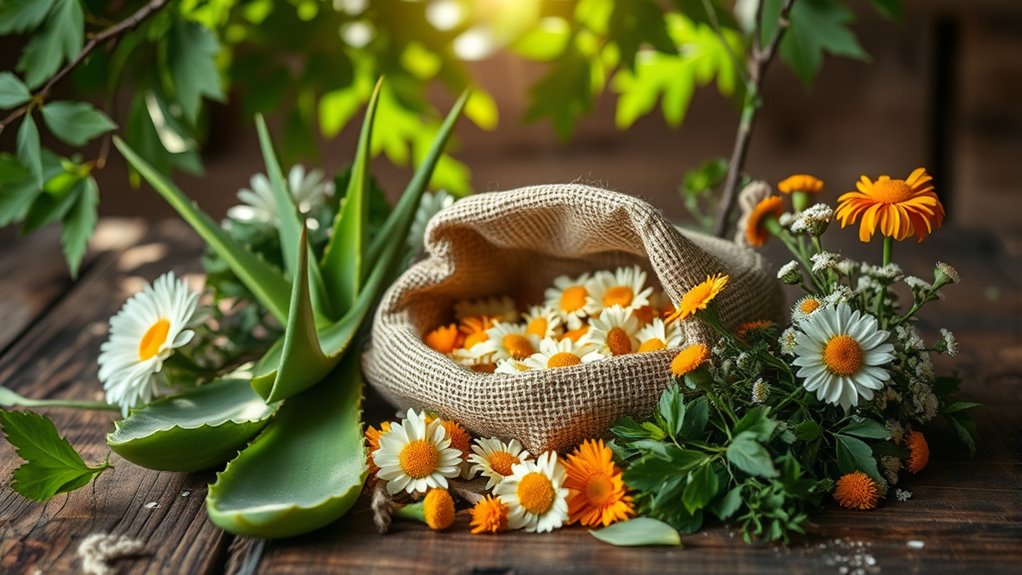
You can use local plants as natural antiseptics and healing agents to treat cuts and wounds effectively. Some plants also serve as plant-based bandages or soothing remedies that speed up recovery. Exploring these options helps you create a reliable first-aid kit from nature’s resources. Additionally, diverse designs in planters can be used to safely contain and apply plant poultices or extracts directly onto injuries.
Natural Antiseptics and Healing Agents
Many plants found in your local environment possess natural antiseptic and healing properties that can be used to treat cuts and wounds. By practicing plant identification, you can harness these herbal medicines for first aid. These plants contain compounds that inhibit bacteria and promote tissue repair, making them invaluable in a wild first-aid kit. Using them effectively requires knowing how to prepare and apply them safely. Having a solid understanding of key traits of successful herbal healers can enhance your ability to utilize these plants effectively.
- Yarrow: Known for its antiseptic and anti-inflammatory qualities, ideal for stopping bleeding.
- Plantain: Has soothing, healing properties and helps draw out toxins.
- Chickweed: Rich in vitamins, supports skin regeneration.
- Calendula: Promotes faster healing and reduces infection risk.
- Comfrey: Contains compounds that encourage tissue growth and repair.
Plant-Based Bandages and Soothers
When treating cuts and wounds in the wild, harnessing the power of certain plants can provide effective, natural bandages and soothing agents. You need to master plant identification to recognize suitable options like yarrow, plantain, and comfrey. These plants have leaves or stems that can be mashed into a poultice or directly applied to wounds, creating a protective barrier and promoting healing. To guarantee sustainability, harvest only what you need and avoid damaging the plant’s roots or overall health. Using these plants as bandages or soothing agents not only reduces reliance on synthetic materials but also encourages responsible foraging. With careful identification and sustainable harvesting, you can craft effective, natural first-aid solutions right from your local flora.
Natural Remedies for Insect Bites and Stings
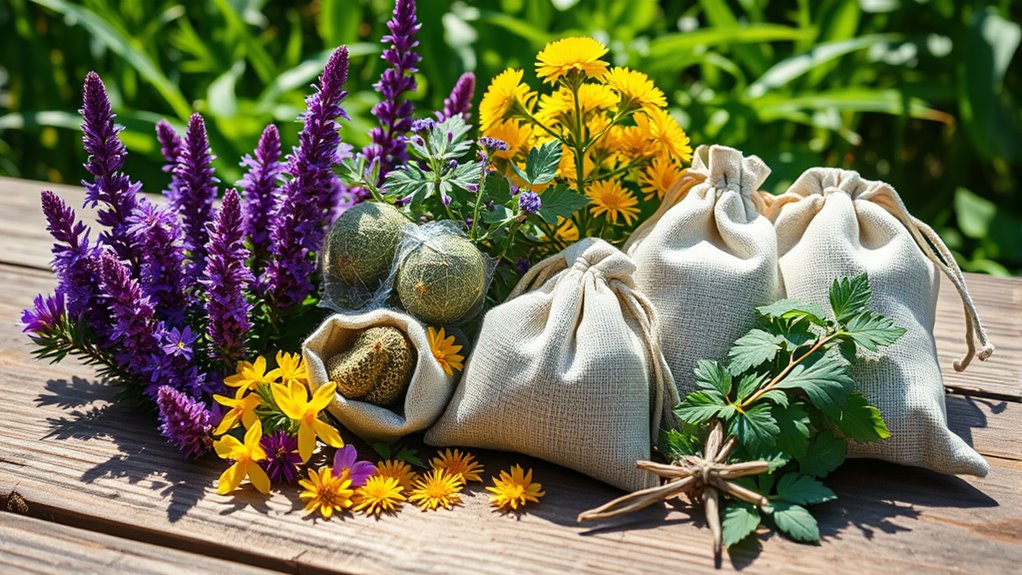
Insect bites and stings can cause discomfort and sometimes lead to infections, but natural remedies from local flora can offer effective relief. By practicing wild plant identification and sustainable harvesting techniques, you can safely gather plants to soothe bites. Some plants have anti-inflammatory and antiseptic properties that help reduce swelling and prevent infection. Using these remedies can be especially beneficial during outdoor activities or in areas with limited access to conventional medicine. Additionally, understanding fetal development can help you recognize the importance of avoiding toxic plants that may harm both you and your unborn baby.
- Apply crushed leaves of plantain to the bite area for quick relief
- Use aloe vera gel from wild aloe plants to reduce itching
- Dab a paste made from yarrow flowers to stop bleeding
- Place a small piece of peeled jewelweed stem on the sting to ease pain
- Collect and dry stinging nettle leaves for future use in salves
Always ensure correct wild plant identification to avoid toxicity.
Soothing Burns and Skin Irritations With Wild Plants

Wild plants can provide natural relief for burns and skin irritations when identified and used correctly. Start with wildflower identification to ensure you’re using safe, non-toxic plants. Common options include plantain, which has soothing properties, and yarrow, known for its anti-inflammatory effects. Always remember plant toxicity awareness; some plants that seem helpful may be harmful if misused. For minor burns, gently crush fresh leaves and apply directly to the affected area to reduce pain and inflammation. Avoid applying any plant that you’re unsure about or that shows signs of toxicity. Proper identification is essential, as many wild plants look similar but can have vastly different effects. Knowing the plant properties can help you choose the most effective remedy and avoid adverse reactions. With careful selection and knowledge, wild plants can be a safe, natural remedy for skin irritations.
Creating Poultices and Compresses From Local Herbs
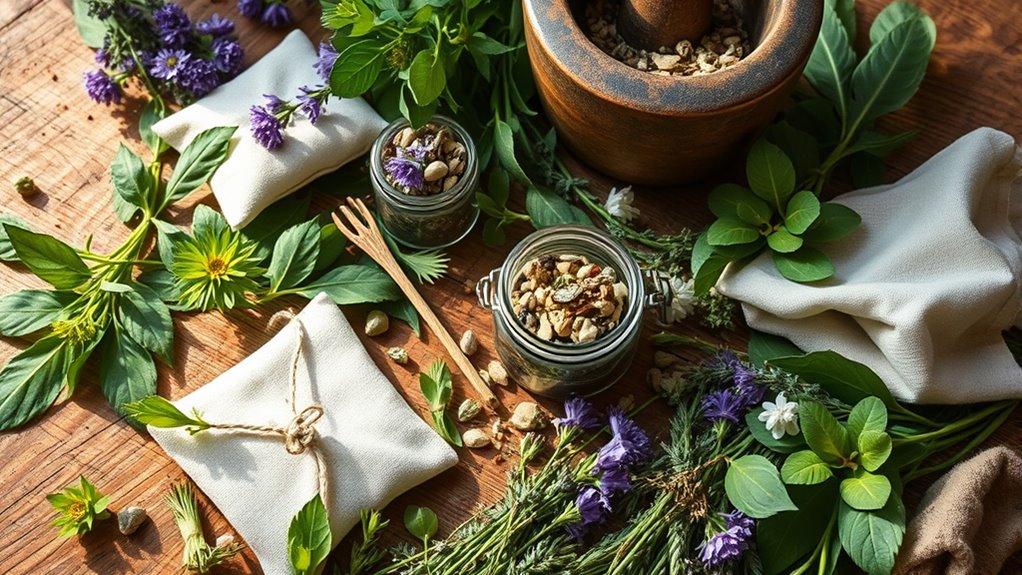
Creating poultices and compresses from local herbs is a simple and effective way to treat injuries and skin conditions using natural remedies. Start by making wild herbal infusions to extract healing compounds. Always prioritize foraging safety—identify plants correctly and harvest sustainably. To prepare, crush or grind fresh or dried herbs into a paste, then spread it directly onto a clean cloth or bandage. Apply the poultice or compress to the affected area, and secure it with a wrap. Remember to change the poultice regularly for ongoing relief. Using local herbs for these remedies taps into nature’s healing power while minimizing chemical exposure. Proper preparation ensures you get maximum benefits from your wild herbal infusions, making your first-aid kit both effective and eco-friendly. Additionally, understanding dog breeds can help owners select suitable animals for outdoor activities like foraging and herbal remedies.
Storage and Carrying of Your Wild First-Aid Supplies

Proper storage and easy access are essential for your wild first-aid supplies, especially when you’re out in the field. You need a sturdy, lightweight container to keep your herbal remedies and tools organized. Use waterproof compartments to protect delicate plant materials and prevent contamination. When carrying supplies, prioritize quick access for emergencies while respecting foraging etiquette—only harvest what’s sustainable and identifiable. Remember, proper plant identification can prevent accidents, so keep a small guide or app handy. Label your containers clearly to streamline your response during urgent moments. Consider a compact, multi-pocket first-aid kit with designated sections for herbs, tools, and instructions.
| Storage Method | Benefits |
|---|---|
| Waterproof pouch | Protects supplies from moisture |
| Compact herbal container | Keeps plant materials organized |
| Lightweight backpack | Easy to carry and access on the go |
Tips for Using and Testing Wild-Prepared Remedies
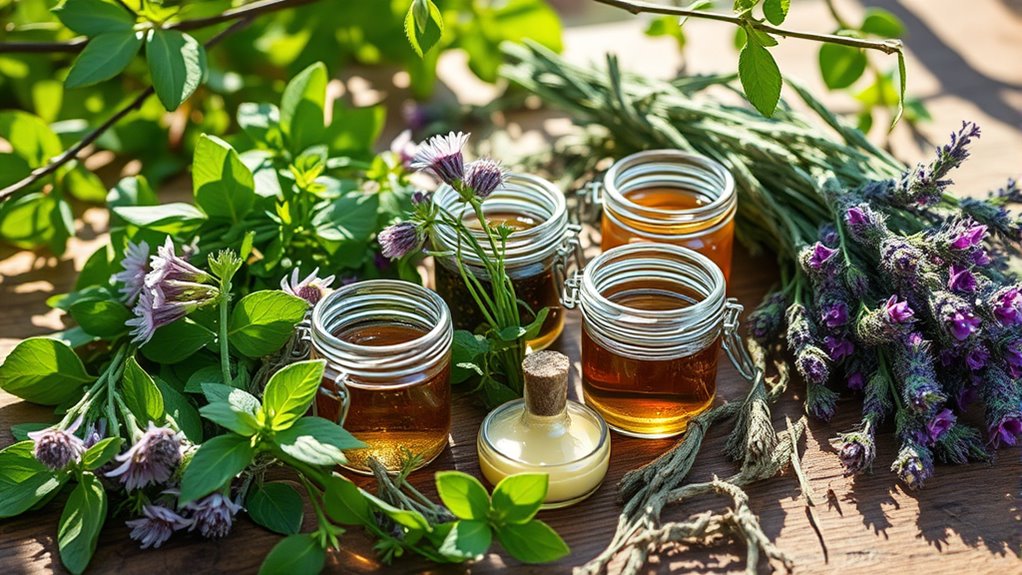
Before using your homemade remedies, it’s essential to test them carefully to guarantee safety and effectiveness. Proper plant identification is crucial to avoid toxic look-alikes, ensuring you’re using the right species. Start by applying a small amount of the remedy to a patch of skin to check for allergic reactions. Remember to harvest plants sustainably, taking only what you need without damaging the ecosystem. Always test each remedy on a small area before broader use. Keep detailed notes about the plant source, preparation method, and any reactions. This practice helps you refine your process and confirms safety. Being aware of proper disposal methods ensures you manage waste responsibly and prevent environmental harm. Careful testing and responsible harvesting make your wild remedies both effective and eco-friendly, giving you confidence in their use during emergencies.
Frequently Asked Questions
How Can I Identify Which Plants Are Safe for First Aid Use?
To identify safe plants for first aid, focus on accurate plant identification through reliable guides or expert advice. Always verify species carefully, as many plants look similar but can be harmful. Follow safety precautions by testing a small skin patch first and avoiding plants with known irritants or toxins. Remember, when in doubt, consult a local expert or botanist to guarantee you’re using the right plants safely for first aid purposes.
What Are Common Mistakes to Avoid When Harvesting Wild Plants?
When doing plant harvesting during wild foraging, avoid common mistakes like taking too much from one area, which can harm the environment. Always properly identify plants before harvesting, as misidentification can be dangerous. Don’t harvest plants that are endangered or protected. Use clean tools, and never harvest from polluted areas. By being cautious and respectful, you guarantee safe plant harvesting and support sustainable wild foraging practices.
How Long Do Homemade Plant Remedies Typically Last?
While homemade plant remedies are handy, their storage duration varies. You might expect tinctures to last months, but potency decline happens over time. Salves and infusions often last a few weeks to months if stored properly in dark, airtight containers. The key is to monitor for changes in smell, color, or texture. Proper storage extends their effectiveness, but always use your senses to judge if a remedy is still safe and potent.
Are There Any Plants That Should Never Be Used Topically?
You should avoid using toxic plants topically, as they can cause serious allergic reactions or skin irritation. Plants like poison ivy, poison oak, and certain hemlocks are well-known for their harmful effects. Always identify plants carefully, and test a small skin patch first. If you experience redness, itching, or swelling, wash the area immediately and seek medical help. Never apply unknown plants directly to your skin without proper knowledge.
How Can I Test the Effectiveness of My Wild First-Aid Remedies Safely?
To test your wild remedies safely, start with safety testing by applying a small amount of the plant extract on your skin, like the inside of your wrist. Watch for any signs of plant toxicity, such as redness or irritation. If no reaction occurs within 24 hours, it’s generally safe to use. Always research plant toxicity beforehand, and consider consulting an expert for proper safety testing methods.
Conclusion
With each carefully gathered leaf and root, you craft a healing tapestry from nature’s own pharmacy. As you tuck your wild first-aid kit into your bag, imagine the forest’s gentle pulse, ready to cradle you in its soothing embrace. Trust your knowledge and instincts, knowing that amidst rustling leaves and sun-dappled shadows, you hold the power to heal and protect, turning local flora into your own sanctuary of safety and resilience.



